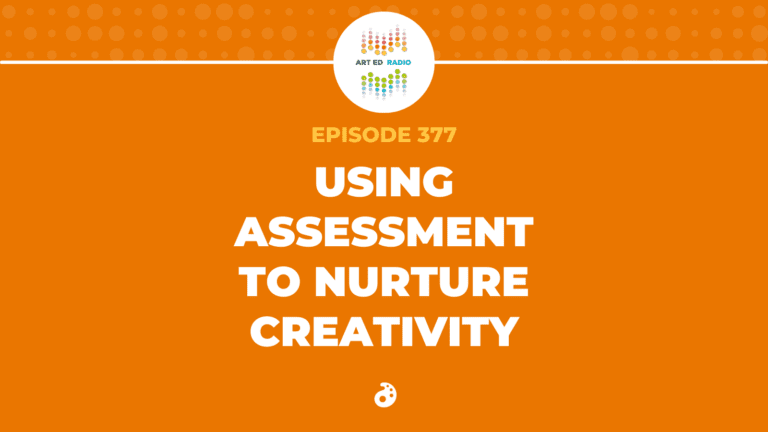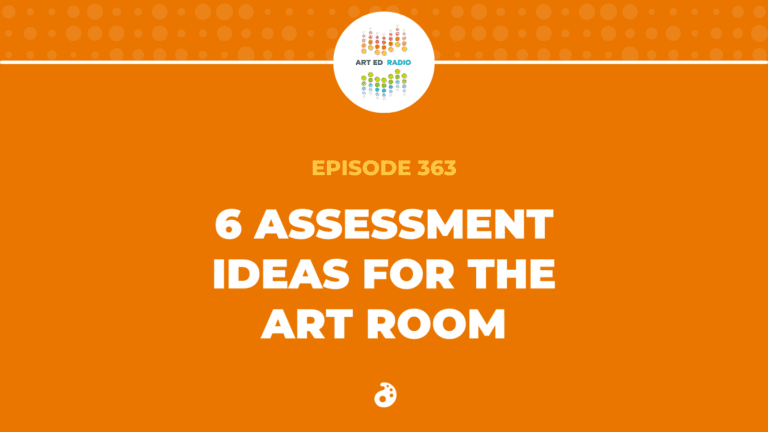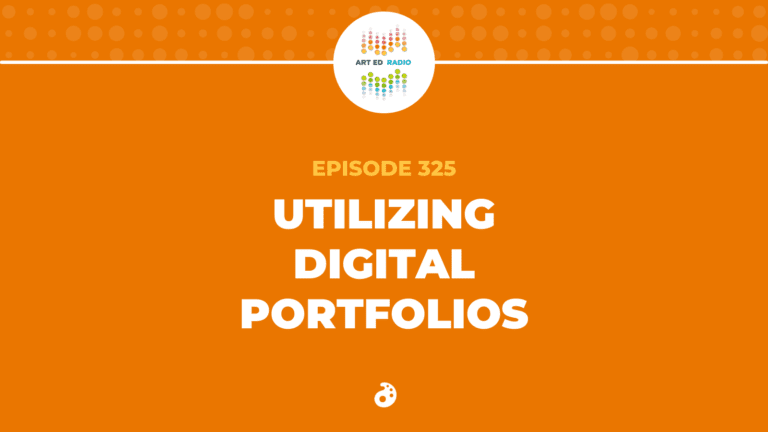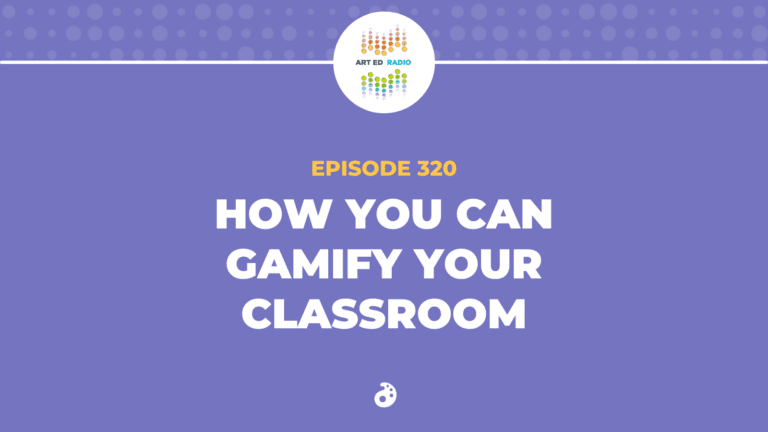For too many art teachers, assessment remains a difficult concept. It’s tough to know what’s going to work, how it can be implemented, and how it can be incorporated to actually help improve teaching. In this episode, Tim takes on some of these concerns and shares his ideas on making assessment valuable. Heather Crocket, the Educational Director at The Art of Ed, joins the show for a conversation on how assessments can actually affect your classroom (10:00), the best formative and summative assessments for the art room (13:15), and why assessment is so difficult for art teachers (17:45). Most importantly, Heather offers some very specific advice on what we can do as art teachers to take on assessment and make it work for us. Full episode transcript below.
Resources and Links:
- A Sample SLO for Art Teachers
- 3 Simple Tricks for Tracking Student Growth
- 20 Quick Formative Assessments You Can Use Today
- AOE’s Assessment in Art Education Course
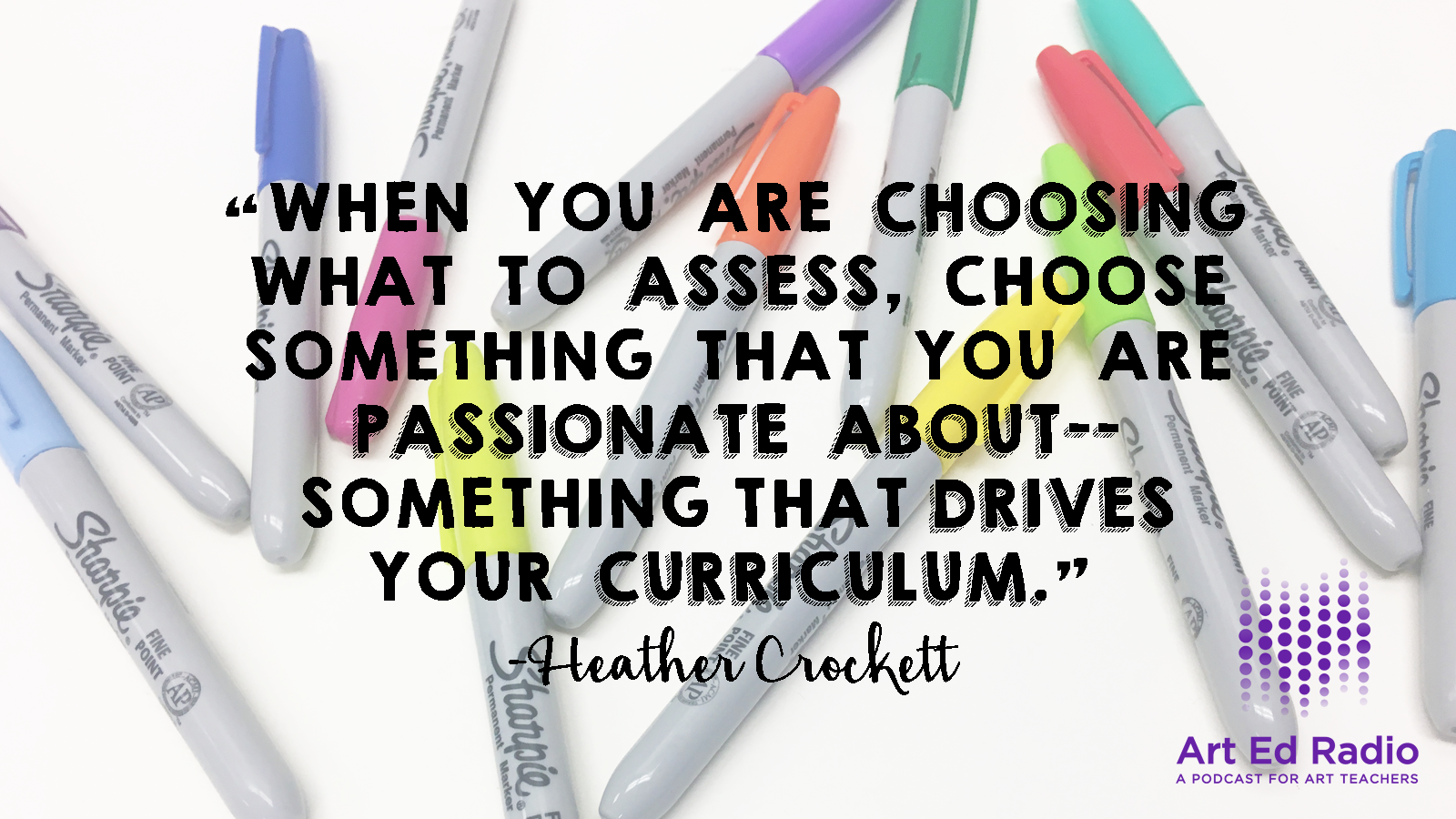
Transcript
Welcome to Art Ed Radio, the podcast for art teachers. This show is produced by The Art of Education and I’m your host, Tim Bogatz.
Let me take you back a ways to my first year of teaching when I was young and impressionable and had no idea what I was doing in the classroom. The important part of that fact, though, is that I was aware of my shortcomings. For me, the biggest part of teaching, that I knew I was unprepared for, was classroom management and because of that, classroom management got most of my attention during my early teaching years and eventually, I got pretty good at it because with enough research and reflection and attention, you can improve pretty much any part of your teaching.
The part of teaching that I ignored and what I want to talk about today, being completely honest, I ignored assessment. I never liked grading, never thought it was that important, and if I was completely oblivious to how important good assessment tools were to a successful classroom. I just ignored it when I could and graded only when it was required of me, but eventually, I came around. The research, the reflection, the attention that I was talking about, eventually turned toward assessment. I got past the idea of tests and required reporting being my only forms of assessment. I realized that problem solving and quality critiques and brainstorming, sketching, collaboration, even conversations with your kids, can all show evidence of learning.
When you give kids options on how they can demonstrate their knowledge, they’re going to be more engaged, there’s going to be more learning in your classroom. That should make you think a little bit about, what is the role of assessment in your classroom? It should be part of what we do everyday, not something separate and not something that you only think about every once in a while or things that you worry about when it comes time for grades. It should be an ongoing process. I see it so often where people learn that they have to write a student learning objective or SLO if you will, and they automatically shut down or look at that requirement as some kind of hoop that they have to jump through. I really think that we need to change that mindset because I think we can use assessment for good instead of looking at it as something that’s inherently evil. Evil may be too strong a word, honestly, but it can be difficult to assess things well and assess things meaningfully, but there are so many ways to do it that, I think, we need to look more closely at all of the possibilities.
We don’t want to look at assessment as being apart from the rest of our teaching because it can inform almost everything that we do and it can help us do it better. We’re going to talk today about different types of assessment and how you can actually make it work for you.
In just a minute, I’m going to bring on Heather Crockett who is the Educational Director for The Art of Ed. She has a lot of great ideas on both, big picture ideas when it comes to assessment and the smaller scale concepts like, how to actually implement them in the classroom.
Before we get there though, I’m going to tell you a little bit about The Art of Ed’s course called, Assessment and Art Education. It’s a three credit, hour course, it runs for five weeks and a new section opens up every single month. It’s amazing because it teaches you how to write meaningful, authentic assessments and everything you do is immediately applicable in your own classroom.
If you want to explore the ideas that we talk about today at any sort of length or, at least, explore them more than we can in a 25 minute podcast, go to theartofed.com/courses and check out assessment and art education.
Now, it is time for our interview. As I talk to Heather, we are going to start with the big picture, narrow it down to a small scale, and get it focused at the end with some specific advice and specific ways that you can bring some quality assessments into your classroom. I know that sounds like a lot, but if anybody is up for it, it is definitely Heather Crockett. Let’s bring her on now.
Tim : I am now here with Heather Crockett. Heather, how are you?
Heather : I’m good.
Tim : Good.
Heather : Thanks for having me.
Tim : We are excited to have you. I’m really glad that you could join us.
I know you do a ton of work as the Educational Director for The Art of Ed, with all the courses and everything going on in the Ed department and not a lot of people know what you do, so can you just explain for our listeners real quick, what your job is at The Art of Ed and what you do as Educational Director?
Heather : Sure. My main job is to oversee, I guess, the entire educational branch for The Art of Ed, which means I get to work with all of our instructors, managing our instructors, scheduling them, doing any trainings, especially, in distance education. I also help to design and develop all of our classes and making sure that they have fresh content available to all of our AOE students.
Tim : Cool. That’s really cool.
The reason I wanted to have you on though is, I don’t know if you’d feel comfortable with me calling you an expert, but I think you are, so we’re going to dive into all kinds of stuff on assessment and you were just the perfect person to do that.
We’ll go ahead and jump in and, I guess, the first question, what I hear the most from listeners and when I’m teaching the assessment course, the thing we talk about most is SLO’s. People seem to be completely lost when it comes to writing these type of objectives and if they’re not lost necessarily, then they are terrified about, how do I do this right? Can you explain an SLO really quickly, for those listeners that don’t know and then, talk about how different teachers may go about or how they may start writing an SLO for their own classroom?
Heather : Sure. An SLO is a process. It’s this big process that has to do with assessment, data, and goals, and the whole point of this whole process is to measure growth. The two things that make an SLO unique, in my mind, and actually make SLO’s kind of cool, which I know, using SLO and cool in the same sentence. One is, that they’re designed to measure growth from your students rather than attainment. Instead of setting a certain proficiency goal that all your students have to reach, you’re instead focusing on the growth that each student makes. We know as teachers that, our students are learning in different ways and they’re learning in different amounts, so that’s really cool. The other thing is that it allows us to measure apples to apples. When you’re doing an SLO, you are judging and measuring, let’s say, Johnny’s growth in the fall to Johnny’s growth in the spring. You’re not comparing Johnny to anyone else, you’re just seeing how much this student grows and this student grows. That’s really neat because it allows us to individualize the assessment for all of our students.
The one thing I will share with you is my favorite SLO and this is one that I think works for almost anybody and that is, it’s pretty general, it’s that 75% of students will make half the growth required to score 100. What that basically means is, if you have a student who scores 60 at the beginning of the year, in order for him to make half the growth, we’d be looking for that student to score and 80 by the end of the year. That might not be the same for all students.
Tim : Yeah, so like a kid who scored a 50 would have to get halfway between 50 and 100 to 75 or a kid that scored 90 would only have to go up five points, 95, because that’s halfway to 100. Am I thinking that right?
Heather : Right. You’re no longer worrying about percentages and grades or anything, it’s just looking at the growth.
Tim : Okay, cool. You said, three fourths of your kids, you think, can meet that goal? Is that doable for most teachers?
Heather : Most of what I see, the goal needs to be around the 75% mark, but different districts have different requirements. Some are 80, some are lower. Some are even 60.
Tim : I think that’s a really good way to explain it. Even if you’re not a math person, then that doesn’t seem too terribly difficult.
After we’ve written a good SLO though, something that works for each of your kids, what do you think are some of the best ways to track that objective? Obviously that’s going to be different for everybody depending on how you measure, what you’re measuring, what level you teach, but what do you think is a good way to be successful when you are trying to track that?
Heather : Checklists are my go to assessment tool. I like them because you can list all of your students in the first column and record data horizontally. You can stick it right on a clipboard and you’re good to go. It’s something you can walk around with or you could even use a checklist digitally. I’d also suggest cozying up to the math expert or tech expert in your building, somebody that can help you with Excel and Pages. Those are amazing platforms, they can help you save a lot of time with this process, but you have to know how to use them. Make friends with people that know how to use those platforms and they can make your life a whole lot easier.
Tim : Yeah, I like that. That’s some good advice.
Then, I guess, the other big question that I hear a lot and things that I see from a lot of different teachers, how can you actually make assessments work for you in the classroom? How can they help your teaching? I think so many teachers look at assessments as just being a hoop that we have to jump through or a standard we have to meet because that’s what our administrators tell us we need to do. How do we shift that thinking and how do we make those assessments applicable to what we are doing in our classroom?
Heather : I love this question, Tim, because I don’t …
Tim : Thank you.
Heather : Like the idea … I don’t like the idea of doing anything that doesn’t directly impact my classroom.
Tim : Right.
Heather : That’s just a waste of time. My advice would be that, when you’re choosing what to measure, you choose something that you’re passionate about, something that drives your curriculum. It helps me to reflect on this question. I like to think about what I would be embarrassed that students in third grade, for example, left my classroom and they didn’t understand. What is keeping me up at night? If I’m not losing sleep because, let’s say, my drawing students can’t create eight shading hues, then that’s not what I’m going to focus on for my SLO. SLO’s take time, so you want to make sure and choose a topic that you care about.
I would also suggest, don’t be afraid to jump into some loftier content like, studio habits and the new visual art standards or critical thinking skills. These could be more challenging to asses, but they’re definitely not a waste of time, in my opinion.
Tim : Yeah, I like that thinking. I’m very big on finding things that you’re passionate about and that really can come to assessment. Like I said, I think you just need to change that mindset and like I said, look at it as something that can help your classroom and then, organize it so that it can help.
Once we’ve decided on what we need to measure, what advice would you give for going about doing it? What are some of your favorite types of, at least, formative assessments? What do you think works well for teachers, maybe doesn’t take a ton of time, but can still lead to some types of successful learning for our students?
Heather : Sure. There are so many great formative assessments out there. An old school approach that I like is a paper folder, a manila folder with Post-it Notes inside, one for each student where I can write down specific notes and running records. That would be an ongoing formative assessment. Technology has done a lot for assessments, even formative assessments. I’ve seen teachers use ClassDojo for formative assessments and this new one called Plickers. It lets you scan the room with your Smartphone and collect data. The students hold up a sign and you can just …
Tim : Nice.
Heather : Collect it so quickly, yeah, and they think it’s a game.
Another thing, I think if you have sketch books in your classroom, they can be a really helpful formative assessment tool, especially if you have the practice and the routine of using them consistently. You could easily do something in a sketchbook.
Tim : Yeah, I like that too. I guess, that actually leads us to kind of a good transition because, I like to use sketchbooks as a summative assessment as well because, I think, it shows a lot of process and a lot of growth, if you’re doing things right with it. If you’re having kids make sketches, brainstorm ideas, practice composition, practice color schemes, all that kind of stuff. We can talk a little bit more about that, but in more general terms, what are you going for or what do you like with summative assessments? Along with sketchbooks, I really like portfolios because again, you see the process, you see the growth and there’s a lot of opportunity for kids, when it comes to reflection and doing self assessment, so what about you? What do you think works best for summative assessments?
Heather : I would have to agree. Portfolios all the way. I like that because they do show growth and they show the whole student. I will say, the key to creating those really top notch portfolios that do show growth, is to make sure that you include a wide body of evidence. You include those sample sketches or your whole sketchbook, your design plans, artist statements like you mentioned, that’s a really great reflective piece. Your whole SLO could be writing better artist statements. You don’t want to just collect those final pieces, you want to tell that whole story and I love using a portfolio for that.
Tim : Yeah, I think that’s a great point and I know this isn’t applicable to everybody or not even close to everyone, but so many of my kids, when they were applying to art schools, they wanted to go into school for graphic design or whatever the case may be, they would think that their portfolio just needed to be all of these final projects, just the best they can do and, honestly, no school just wants to see your final product just like no assessment should be just about the final product. Those portfolios and all of those summative assessments really need to show that growth and that development. Like you said, the wide body of evidence is really the way to go.
When we are talking about big things like portfolios or even the smaller things like just taking notes like you’re Post-it folder idea where you’re taking notes on each student, are ideas like that really doable if you have three hundred students? Thinking about it pragmatically, is there some place small we can start, so we are not overwhelmed by trying to do this assessment with an entire school?
Heather : That’s a really great question also, Tim, and one that we do get a lot in the assessment class. I am a huge advocate for starting small, if at all possible. It really depends on the requirements of your district, but it never hurts to ask for a year to pilot your SLO with a smaller group.
Tim : Oh, yeah, that’s good.
Heather : I would try to pilot with one class or one grade level that first year or two, which allows you the opportunity to develop your assessment tools and hone your skills to make your process refined and manageable and replicable on a larger scale. That way, you kind of eliminate the stress of the quantity, so you can really work on the quality piece and how you’re going to get all these pieces into place before you go big, I guess.
Tim : Yeah, I like that. That’s a really great suggestion. I think that trial by error can really … I mean, this is difficult anyway and so, if you have time to work out the kinks and try and fix those errors, I think that can be key. I think that’s some really, really good advice.
After all of these ideas that you’re throwing at me, I know there is still going to be teachers who are really hesitant to dive into assessment. This is kind of a two part question. First of all, why do you think assessment is such a difficult or such a scary topic for teachers? Then secondly, what advice can you give them to get past that and get them started?
Heather : I think assessment can be a leery topic for teachers, for art teachers especially, for a couple reasons. The first one is, we are not trained in assessment, we’re trained in visual arts and writing quality assessments, making sure they measure exactly what we want them to measure and analyzing data, those are all a process and skills that take time to develop and I think a lot of times, we just feel unsupported when we are given these tasks and we’re not sure where to begin with that. I think that’s a honest feeling.
Also, I think that unlike other subject areas, art doesn’t always have a really specific curriculum that we have to follow and we also don’t have the standardized assessment to fall back on, which, in my opinion, is not a bad thing …
Tim : Yeah, I was just going to say that.
Heather : Right? You want all that.
Tim : Yes.
Heather : Because often, we’re asked to create the curriculum. We’re kind of like the MacGyvers of education in a way. We take this art room and the supplies we’re given or the cart, we get a sink or not, supplies, whatever. We make this beautiful art curriculum out of it and then, when we are asked, “Well, are you sure they’re growing? Are you sure they’re making progress?” You get a little defensive and so …
Tim : Yeah.
Heather : I understand that.
My advice to get over that, I have four pieces of advice that helped me get over this hurtle. First one is choosing a topic that you’re passionate about. I talked about it before, but I really think that’s key because, otherwise, you’re just going to feel like it’s a waste of time, a hoop, right? If you can do something that you’re passionate about, the data that you’re collecting will be more enjoyable and it will be more meaningful to you and so, it will be just a more enjoyable process.
The second thing is to start small. If you possibly can, ask for that pilot and hone your skills. Give yourself that time to develop your process.
The third thing is to network. Use your PLN, seek out help with your assessments. If you’re not sure where to start, ask for help. Ask for help with the data collection tools like I talked about with the platform and Excel. You don’t have to do this by yourself, there are people our there and actually, there are more and more really cool resources out there because Gen Ed is starting to get into this project based stuff like, 20% Time and Genius Hour. I just came across something called a GRIT Rubric. That stand for Guts, Resilience, Integrity, and Tenacity. It’s from the College Track program in San Francisco, has nothing to do with visual arts, it has everything to do with process and measuring the process rather than the product. Really pretty cool. There’s more and more stuff, I think, coming out there that we can pull from and network.
Then, the fourth thing is just to jump in. Just do it. Worst case scenario, your students will not demonstrate any growth and I seriously doubt that, that’s going to be the case, right?
Tim : Yeah.
Heather : Our students are always growing and improving, so we just need to jump in. If our assessment doesn’t exactly measure what we want it to, it’s okay. You tried. You got to start somewhere, so I just think you need to jump in.
Tim : Yeah, that’s good. That’s, yeah, four really, really good pieces of advice, so I like that quite a bit.
I think that’s going to do it for us though. I think that’s a good note to go out on.
Heather, thank you very much for joining us and thank you for all of this awesome advice.
Heather : Absolutely. Thank you for having me.
Tim : Yeah, we’ll talk to you soon.
Heather : All right.
Tim : Awesome. I think that interview accomplished exactly what we wanted to do. We talked big picture with assessment, why it’s important and how to approach it. We talked formative and summative assessments, what works best. I think, most importantly, how you can implement a lot of these ideas. Decide what you’re passionate about, start on a small scale, and slowly work your way into bigger and better things.
If you take anything away from this episode, I think, the end of it there was key. Take away Heather’s four points that she finished the interview with.
First, pick a topic you care about. Something that drives you, something that you have passion for, something that informs your teaching. Make sure it holds your interest because that is what will make your assessment valuable, not only to you and your teaching, but to your students as well.
Secondly, start small. Hone your skills with one class at a time, see what works, what doesn’t, and what you can improve before you roll it out to every single class and every single student.
Third, don’t be afraid to ask for help. There are a lot of people our there that know a lot more than you and you might as well use them. Whether that is somebody with more assessment expertise looking over things that you are trying to do or somebody with, Heather said, the Excel spreadsheet knowledge, that can help you learn how to document your data and what to do with it. There are a lot of people out there that can help you on your journey to finding the right assessments and making them work for you.
Then lastly, like she said, just dive in. You don’t have to know everything right away, you don’t have to be scared, just be confident and dive in and make sure that, always in your mind, you are assessing the things that you are passionate about, things that are going to help your teaching, and things that are going to help your students because if you keep those in mind, you will be able to create some assessments that you really can love.
Art Ed Radio was developed, produced, and supported by The Art of Education with audio engineering by Michael Crocker.
You can see more from the podcast on artedradio.com and you can sign up for the weekly Art Ed Radio email.
Like I said, if you thought this was a good episode, take a look at the Assessment in Art Education Course where you can dive deep into some of these ideas and make it all applicable to your own classroom. Find it at theartofed.com/courses.
Thanks, as always, for listening and we will see you next week.
Magazine articles and podcasts are opinions of professional education contributors and do not necessarily represent the position of the Art of Education University (AOEU) or its academic offerings. Contributors use terms in the way they are most often talked about in the scope of their educational experiences.
